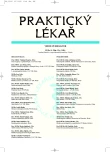Cardiac complications of subarachnoidal haemorrhage.
Authors:
O. Myslivec 1; T. Kos 2; R. Surovčík 3; M. Pokorný 1; F. Paďour 1; P. Niederle 4
Authors‘ workplace:
I. interní oddělení FN na Bulovce
Primář: MUDr. František Paďour
1; Radiagnostická klinika 1. LF UK FN na Bulovce
Přednosta: prof. MUDr. Josefa Bohutová, DrSc.
2; Kardiologie na Bulovce s. r. o.
Primář: MUDr. Pavel Jebavý, CSc.
3; Kardiologické oddělení Nemocnice na Homolce
Primář: Prof. MUDr. Petr Niederle, DrSc.
4
Published in:
Prakt. Lék. 2007; 87(7): 428-432
Category:
Case Report
Overview
The risk factors for ischemic heart disease are generally known and, in the case of arterial hypertension, smoking and alcohol abuse are also commensurate with the main etiopathogenetic factors of non-traumatic cerebral haemorrhage. Concurrently, incidents of acute haemorrhagic ictus and acute coronary syndrome are rare in clinical practice. We present the case of a 61 year old male patient with sudden loss of consciousness and circulatory arrest. The cause was extensive subarachnoidal bleeding complicated by ventricular fibrillation concurrently with transitory myocardial ischemia, which manifested as acute coronary syndrome with elevated ST segments. We point out the dangers which can arise during the diagnosis and treatment of an unconscious patient with circulatory arrest and stress the cardiac complications attendant with acute cases of subarachnoidal haemorrhage.
Key words:
subarachnoidal haemorrhage, acute coronary syndrome, atrial fibrillation, ischaemic heart disease.
Labels
General practitioner for children and adolescents General practitioner for adultsArticle was published in
General Practitioner

2007 Issue 7
Most read in this issue
- Acute neuroborreliosis
- Diagnosyis – iron deficiency
- Assessing oral health-related quality of life in Czech population
- Psychological aspects of acute pain
